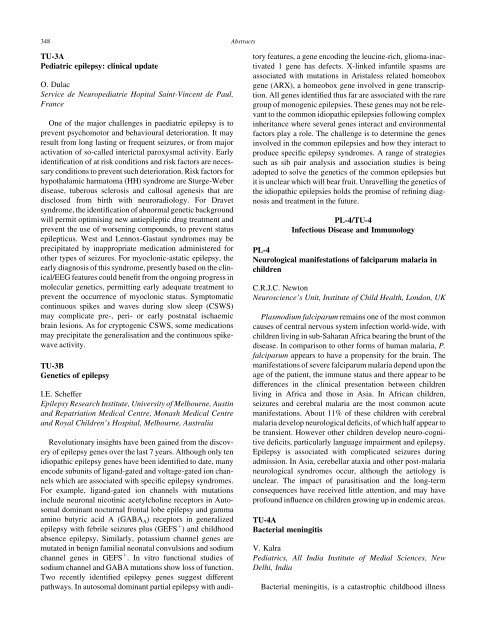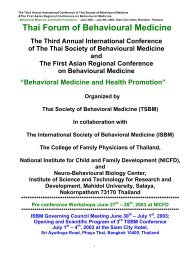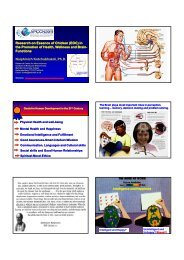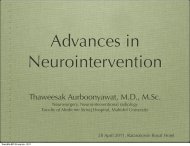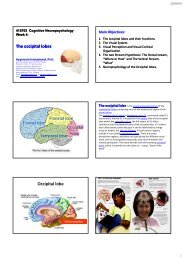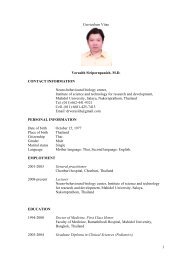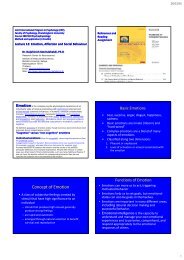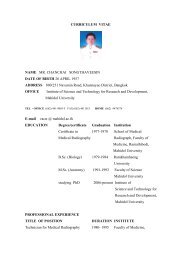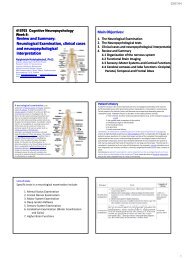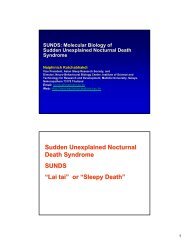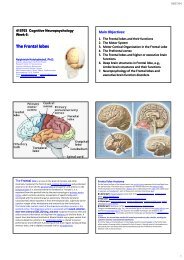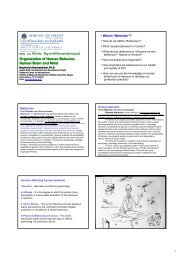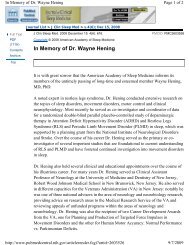PDF File - Mahidol University
PDF File - Mahidol University
PDF File - Mahidol University
You also want an ePaper? Increase the reach of your titles
YUMPU automatically turns print PDFs into web optimized ePapers that Google loves.
348<br />
Abstracts<br />
TU-3A<br />
Pediatric epilepsy: clinical update<br />
O. Dulac<br />
Service de Neuropediatrie Hopital Saint-Vincent de Paul,<br />
France<br />
One of the major challenges in paediatric epilepsy is to<br />
prevent psychomotor and behavioural deterioration. It may<br />
result from long lasting or frequent seizures, or from major<br />
activation of so-called interictal paroxysmal activity. Early<br />
identification of at risk conditions and risk factors are necessary<br />
conditions to prevent such deterioration. Risk factors for<br />
hypothalamic harmatoma (HH) syndrome are Sturge-Weber<br />
disease, tuberous sclerosis and callosal agenesis that are<br />
disclosed from birth with neuroradiology. For Dravet<br />
syndrome, the identification of abnormal genetic background<br />
will permit optimising new antiepileptic drug treatment and<br />
prevent the use of worsening compounds, to prevent status<br />
epilepticus. West and Lennox-Gastaut syndromes may be<br />
precipitated by inappropriate medication administered for<br />
other types of seizures. For myoclonic-astatic epilepsy, the<br />
early diagnosis of this syndrome, presently based on the clinical/EEG<br />
features could benefit from the ongoing progress in<br />
molecular genetics, permitting early adequate treatment to<br />
prevent the occurrence of myoclonic status. Symptomatic<br />
continuous spikes and waves during slow sleep (CSWS)<br />
may complicate pre-, peri- or early postnatal ischaemic<br />
brain lesions. As for cryptogenic CSWS, some medications<br />
may precipitate the generalisation and the continuous spikewave<br />
activity.<br />
TU-3B<br />
Genetics of epilepsy<br />
I.E. Scheffer<br />
Epilepsy Research Institute, <strong>University</strong> of Melbourne, Austin<br />
and Repatriation Medical Centre, Monash Medical Centre<br />
and Royal Children’s Hospital, Melbourne, Australia<br />
Revolutionary insights have been gained from the discovery<br />
of epilepsy genes over the last 7 years. Although only ten<br />
idiopathic epilepsy genes have been identified to date, many<br />
encode subunits of ligand-gated and voltage-gated ion channels<br />
which are associated with specific epilepsy syndromes.<br />
For example, ligand-gated ion channels with mutations<br />
include neuronal nicotinic acetylcholine receptors in Autosomal<br />
dominant nocturnal frontal lobe epilepsy and gamma<br />
amino butyric acid A (GABA A ) receptors in generalized<br />
epilepsy with febrile seizures plus (GEFS 1 ) and childhood<br />
absence epilepsy. Similarly, potassium channel genes are<br />
mutated in benign familial neonatal convulsions and sodium<br />
channel genes in GEFS 1 . In vitro functional studies of<br />
sodium channel and GABA mutations show loss of function.<br />
Two recently identified epilepsy genes suggest different<br />
pathways. In autosomal dominant partial epilepsy with auditory<br />
features, a gene encoding the leucine-rich, glioma-inactivated<br />
1 gene has defects. X-linked infantile spasms are<br />
associated with mutations in Aristaless related homeobox<br />
gene (ARX), a homeobox gene involved in gene transcription.<br />
All genes identified thus far are associated with the rare<br />
group of monogenic epilepsies. These genes may not be relevant<br />
to the common idiopathic epilepsies following complex<br />
inheritance where several genes interact and environmental<br />
factors play a role. The challenge is to determine the genes<br />
involved in the common epilepsies and how they interact to<br />
produce specific epilepsy syndromes. A range of strategies<br />
such as sib pair analysis and association studies is being<br />
adopted to solve the genetics of the common epilepsies but<br />
it is unclear which will bear fruit. Unravelling the genetics of<br />
the idiopathic epilepsies holds the promise of refining diagnosis<br />
and treatment in the future.<br />
PL-4/TU-4<br />
Infectious Disease and Immunology<br />
PL-4<br />
Neurological manifestations of falciparum malaria in<br />
children<br />
C.R.J.C. Newton<br />
Neuroscience’s Unit, Institute of Child Health, London, UK<br />
Plasmodium falciparum remains one of the most common<br />
causes of central nervous system infection world-wide, with<br />
children living in sub-Saharan Africa bearing the brunt of the<br />
disease. In comparison to other forms of human malaria, P.<br />
falciparum appears to have a propensity for the brain. The<br />
manifestations of severe falciparum malaria depend upon the<br />
age of the patient, the immune status and there appear to be<br />
differences in the clinical presentation between children<br />
living in Africa and those in Asia. In African children,<br />
seizures and cerebral malaria are the most common acute<br />
manifestations. About 11% of these children with cerebral<br />
malaria develop neurological deficits, of which half appear to<br />
be transient. However other children develop neuro-cognitive<br />
deficits, particularly language impairment and epilepsy.<br />
Epilepsy is associated with complicated seizures during<br />
admission. In Asia, cerebellar ataxia and other post-malaria<br />
neurological syndromes occur, although the aetiology is<br />
unclear. The impact of parasitisation and the long-term<br />
consequences have received little attention, and may have<br />
profound influence on children growing up in endemic areas.<br />
TU-4A<br />
Bacterial meningitis<br />
V. Kalra<br />
Pediatrics, All India Institute of Medial Sciences, New<br />
Delhi, India<br />
Bacterial meningitis, is a catastrophic childhood illness


